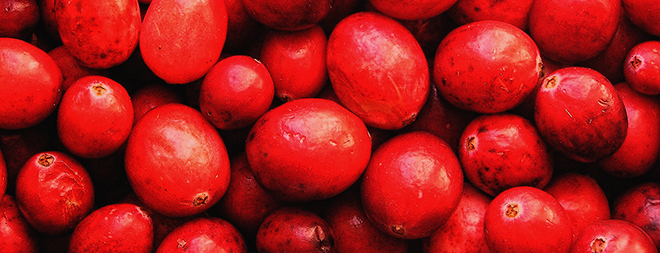Cranberries Stop Bacteria In Their Tracks

(ISNS) – For over a century cranberries have been more than a Thanksgiving staple; they've also been heralded for their reported ability to prevent and even treat urinary tract infections.
But clinical research attempting to link cranberry consumption to a reduction in urinary tract infections remains somewhat inconsistent. A 2012 study by a team from Taiwan and the U.S., published in the Archives of Internal Medicine, found that consuming cranberries did seem to prevent urinary tract infections in certain populations, but qualified the findings with a strong word of caution against using the "folk remedy" as a treatment.
Most research on the cranberry's effect on infections focuses primarily on its ability to prevent bacteria from attaching to a host cell. If the bacteria can't stick to bladder cells, they can't cause infections. But, in recent years, researchers at McGill University in Montreal have uncovered a new weapon that cranberries have against bacteria.
Bacteria on the move
A key factor in a bacterium's ability to infect a host cell is its motility, or how well it can move around. For some types of bacteria, their motility depends in part on their whip-like appendages known as flagella. The flagella allow the bacteria to swim around and, in some cases, actually swarm. The more bacteria can move, the more virulent they can become. This is especially the case in bacteria that cause urinary tract infections.
"Motility is actually a really important factor in infection," said Nathalie Tufenkji, a chemical engineer at McGill University. "It helps the bacteria spread up the urinary tract. It helps them also infect the cells."
Tufenkji and her colleagues were interested in discovering what the compounds in cranberries did to certain bacteria's gene expression.
Get the world’s most fascinating discoveries delivered straight to your inbox.
They took E. coli that had been isolated from the urinary tract and exposed it to different concentrations of cranberry powder. They saw that when the cranberry powder was present, the E. coli's ability to swim and swarm dramatically decreased.
"When they swim and they swarm, what they are using? Well, they're using the flagella. So we said, OK, it must be affecting somehow the flagellum," explained Tufenkji.
Then, Tufenkji looked at how exposure to the cranberry influences bacteria's gene expression, specifically the way the flagella are constructed.
Bacteria that were grown in the presence of cranberries did not produce as many of the genes needed to construct flagella. Without functional flagella, the bacteria's motility was significantly hindered.
This research was published in the October 2011 issue of Applied and Environmental Microbiology.
Cranberry meets Proteus mirabilis
After observing E. coli's impaired motility after exposure to cranberries, Tufenkji tested the cranberry's effect on another bacteria common to urinary tract infections: Proteus mirabilis. This study was published in the June 2013 issue of the Canadian Journal of Microbiology.
"Proteus is this really aggressive swarmer," commented Tufenkji, which makes it particularly virulent in the urinary tract, especially in catheterized patients who already have a high risk of infection.
When patients are catheterized, any bacterium present on the catheter can easily swim or swarm its way up the urinary tract to infect bladder cells.
When the Proteus bacteria were exposed to high concentrations of cranberry powder, the researchers saw two interesting effects. First, just as in E. coli, the bacteria's ability to swim or swarm across an agar plate embedded with cranberry powder was almost completely eliminated.
Second, cranberry powder also appeared to disrupt the bacteria's production of the urease accessory gene, which affects how virulent the bacteria can become.
"This work is very interesting," said Terri A. Camesano, a chemical engineer at Worcester Polytechnic Institute in Massachusetts. "A lot of the other research is focusing on surface activity [of bacteria] and there's relatively less…on motility and how cranberry products affect certain gene expressions associated with flagellum motility."
An alternative to antibiotics
The two studies show that cranberry powder is able to essentially disable bacteria, but it does not kill the bacteria, "and that is key," said Tufenkji.
When antibiotics are used to treat infections, most bacteria are killed, but in the process any survivors can become resistant to the antibiotic used against them. The more often antibiotics are used, the more resistant the bacteria can become, resulting in dangerous strains of antibiotic-resistant bacteria.
Because cranberry powder only disables bacteria, the bacteria are not given the chance to grow stronger as they resist antibiotic intervention. Eventually, the disabled bacteria are simply flushed out of the body. As yet, it is unclear if the bacteria would eventually develop a resistance to the immobilizing effects of the cranberry, but researchers do know that the bacteria does not mutate in response to the cranberry powder.
Cranberry-laced catheters
The concentrations of cranberry powder that were effective in disabling E. coli and Proteus were higher than what would typically be found in a human body, even if a person were intentionally drinking several glasses of cranberry juice daily to prevent or treat a urinary tract infection. So it is difficult to say that ingesting high volumes of cranberries would have any effect on bacterial motility.
In future research, however, Tufenkji plans to examine the effects of embedding cranberry powder into catheters themselves.
"The more people study cranberries the more we realize that there are clearly multiple different mechanisms going on by which cranberry compounds interact with bacteria that affects their potential to cause infection," said Camesano.
This story was provided by Inside Science News Service. Sara Suchy is a News Editor and Web Content Manager for Inside Science.


